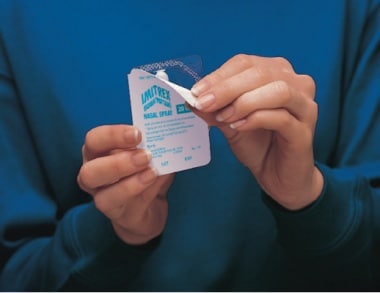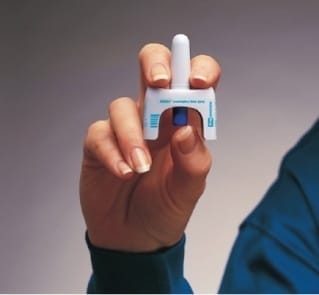What is Imitrex Nasal Spray?
Imitrex Nasal Spray is a prescription medicine used to treat acute migraine headaches with or without aura in adults.
Imitrex Nasal Spray is not used to treat other types of headaches such as hemiplegic (that make you unable to move on one side of your body) or basilar (rare form of migraine with aura) migraines.
Imitrex Nasal Spray is not used to prevent or decrease the number of migraine headaches you have.
It is not known if Imitrex Nasal Spray is safe and effective to treat cluster headaches.
It is not known if Imitrex Nasal Spray is safe and effective in children under 18 years of age.
What is the most important information I should know about Imitrex Nasal Spray?
Imitrex Nasal Spray can cause serious side effects, including:
Heart attack and other heart problems. Heart problems may lead to death.
Stop taking Imitrex Nasal Spray and get emergency medical help right away if you have any of the following symptoms of a heart attack:
- discomfort in the center of your chest that lasts for more than a few minutes, or that goes away and comes back
- severe tightness, pain, pressure, or heaviness in your chest, throat, neck, or jaw
- pain or discomfort in your arms, back, neck, jaw, or stomach
- shortness of breath with or without chest discomfort
- breaking out in a cold sweat
- nausea or vomiting
- feeling lightheaded
Imitrex Nasal Spray is not for people with risk factors for heart disease unless a heart exam is done and shows no problem. You have a higher risk for heart disease if you:
- have high blood pressure
- have high cholesterol levels
- smoke
- are overweight
- have diabetes
- have a family history of heart disease
Who should not take Imitrex Nasal Spray?
Do not use Imitrex Nasal Spray if you have:
- an allergy to sumatriptan or any of the ingredients in Imitrex Nasal Spray. See the end of this guide for a complete list of ingredients in Imitrex Nasal Spray.
- heart problems or a history of heart problems
- narrowing of blood vessels to your legs, arms, stomach, or kidneys (peripheral vascular disease)
- uncontrolled high blood pressure
- severe liver problems
- hemiplegic migraines or basilar migraines. If you are not sure if you have these types of migraines, ask your healthcare provider.
- had a stroke, transient ischemic attacks (TIAs), or problems with your blood circulation
- taken any of the following medicines in the last 24 hours:
- almotriptan (Axert)
- frovatriptan (Frova)
- rizatriptan (Maxalt, Maxalt-MLT)
- ergotamines (Cafergot, Ergomar, Migergot)
- eletriptan (Relpax)
- naratriptan (Amerge)
- sumatriptan and naproxen (Treximet)
- dihydroergotamine (D.H.E. 45, Migranal)
Ask your healthcare provider if you are not sure if your medicine is listed above.
What should I tell my healthcare provider before taking Imitrex Nasal Spray?
Before you use Imitrex Nasal Spray, tell your healthcare provider about all of your medical conditions, including if you:
- have high blood pressure.
- have high cholesterol.
- have diabetes.
- smoke.
- are overweight.
- have heart problems or family history of heart problems or stroke.
- have kidney problems.
- have liver problems.
- have had epilepsy or seizures.
- are not using effective birth control.
- are pregnant or plan to become pregnant. It is not known if Imitrex Nasal Spray can harm your unborn baby.
- are breastfeeding or plan to breastfeed. Imitrex Nasal Spray passes into your breast milk. It is not known if this can harm your baby. Talk with your healthcare provider about the best way to feed your baby if you use Imitrex Nasal Spray.
Tell your healthcare provider about all the medicines you take, including prescription and over-the-counter medicines, vitamins, and herbal supplements.
Imitrex Nasal Spray and certain other medicines can affect each other, causing serious side effects.
Especially tell your healthcare provider if you take antidepressant medicines called:
- selective serotonin reuptake inhibitors (SSRIs)
- serotonin norepinephrine reuptake inhibitors (SNRIs)
- tricyclic antidepressants (TCAs)
- monoamine oxidase inhibitors (MAOIs)
Ask your healthcare provider or pharmacist for a list of these medicines if you are not sure.
Know the medicines you take. Keep a list of them to show your healthcare provider or pharmacist when you get a new medicine.
How should I use Imitrex Nasal Spray?
- Certain people should use their first dose of Imitrex Nasal Spray in their healthcare provider’s office or in another medical setting. Ask your healthcare provider if you should use your first dose in a medical setting.
- Use Imitrex Nasal Spray exactly as your healthcare provider tells you to use it.
- Your healthcare provider may change your dose. Do not change your dose without first talking with your healthcare provider.
- If you do not get any relief after your first nasal spray, do not use a second nasal spray without first talking with your healthcare provider.
- If your headache comes back after the first nasal spray or you only get some relief from your headache, you can use a second nasal spray 2 hours after the first nasal spray.
- Do not use more than 40 mg of Imitrex Nasal Spray nasal spray in a 24‑hour period.
- It is not known how using Imitrex Nasal Spray nasal spray for a long time affects the nose and throat.
- If you use too much Imitrex Nasal Spray, call your healthcare provider or go to the nearest hospital emergency room right away.
- You should write down when you have headaches and when you use Imitrex Nasal Spray so you can talk with your healthcare provider about how Imitrex Nasal Spray is working for you.
What should I avoid while using Imitrex Nasal Spray?
Imitrex Nasal Spray can cause dizziness, weakness, or drowsiness. If you have these symptoms, do not drive a car, use machinery, or do anything where you need to be alert.
What are the possible side effects of Imitrex Nasal Spray?
Imitrex Nasal Spray may cause serious side effects. See “What is the most important information I should know about Imitrex Nasal Spray?”
These serious side effects include:
- changes in color or sensation in your fingers and toes (Raynaud’s syndrome)
- stomach and intestinal problems (gastrointestinal and colonic ischemic events). Symptoms of gastrointestinal and colonic ischemic events include:
- sudden or severe stomach pain
- stomach pain after meals
- weight loss
- fever
- nausea or vomiting
- constipation or diarrhea
- bloody diarrhea
- problems with blood circulation to your legs and feet (peripheral vascular ischemia). Symptoms of peripheral vascular ischemia include:
- cramping and pain in your legs or hips
- feeling of heaviness or tightness in your leg muscles
- burning or aching pain in your feet or toes while resting
- numbness, tingling, or weakness in your legs
- cold feeling or color changes in 1 or both legs or feet
- medication overuse headaches. Some people who use too many Imitrex Nasal Spray nasal sprays may have worse headaches (medication overuse headache). If your headaches get worse, your healthcare provider may decide to stop your treatment with Imitrex Nasal Spray.
- serotonin syndrome. Serotonin syndrome is a rare but serious problem that can happen in people using Imitrex Nasal Spray, especially if Imitrex Nasal Spray is used with anti-depressant medicines called SSRIs or SNRIs.
- Call your healthcare provider right away if you have any of the following symptoms of serotonin syndrome:
- mental changes such as seeing things that are not there (hallucinations), agitation, or coma
- fast heartbeat
- changes in blood pressure
- high body temperature
- tight muscles
- trouble walking
- local irritation. Some people who use Imitrex Nasal Spray nasal spray may have irritation of their throat and nose. Symptoms of local irritation of the throat and nose include: burning, numbness, tingling sensation, nasal discharge, pain or soreness.
- hives (itchy bumps); swelling of your tongue, mouth, or throat.
- seizures. Seizures have happened in people taking Imitrex Nasal Spray who have never had seizures before. Talk with your healthcare provider about your chance of having seizures while you take Imitrex Nasal Spray.
The most common side effects of Imitrex Nasal Spray nasal spray include:
- unusual or bad taste in your mouth
- nausea
- vomiting
- dizziness
- warm, hot, burning feeling
Tell your healthcare provider if you have any side effect that bothers you or that does not go away.
These are not all the possible side effects of Imitrex Nasal Spray.
Call your doctor for medical advice about side effects. You may report side effects to FDA at 1-800-FDA-1088.
General information about the safe and effective use of Imitrex Nasal Spray
Medicines are sometimes prescribed for purposes other than those listed in Patient Information leaflets. Do not use Imitrex Nasal Spray for a condition for which it was not prescribed. Do not give Imitrex Nasal Spray to other people, even if they have the same symptoms you have. It may harm them.
This Patient Information guide summarizes the most important information about Imitrex Nasal Spray. If you would like more information, talk with your healthcare provider. You can ask your healthcare provider or pharmacist for information about Imitrex Nasal Spray that is written for healthcare professionals.
For more information, go to www.gsk.com or call 1-888-825-5249.
How should I store Imitrex Nasal Spray?
- Store Imitrex Nasal Spray between 36°F to 86°F (2°C to 30°C).
- Store your medicine away from light.
Keep Imitrex Nasal Spray and all medicines out of the reach of children.
What are the ingredients in Imitrex Nasal Spray?
Active ingredient: sumatriptan
Inactive ingredients: monobasic potassium phosphate NF, anhydrous dibasic sodium phosphate USP, sulfuric acid NF, sodium hydroxide NF, and purified water USP.
Instructions for use
IMITREX (IM-i-trex)
(sumatriptan)
nasal spray
For use in the nose only. Do not spray in your eyes.
 |
Step 1. Remove the Imitrex nasal spray unit from the plastic pack. Do not remove the unit until you are ready to use. The unit contains only 1 spray. Do not test before use. |
 |
Step 2. While sitting down, gently blow your nose to clear your nasal passages. |
 |
Step 3. Keeping your head in an upright position, gently close 1 nostril with your index finger and breathe out gently through your mouth. |
 |
Step 4. With your other hand, hold the container with your thumb supporting the container at the bottom, and your index and middle fingers on either side of the nozzle. Insert the nozzle into your open nostril about ½ inch. Do not press the blue plunger yet. |
 |
Step 5. Keep your head upright and close your mouth. While gently taking a breath in through your nose, press the blue plunger firmly to release the dose of Imitrex nasal spray. |
 |
Step 6. Keep your head level and remove the nozzle from your nostril. While holding your head level, gently breathe in through your nose and out through your mouth for 10 to 20 seconds. Do not breathe in deeply. |




